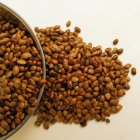Related articles
-
 समुद्र तट, प्रकृति का जादुई सौंदर्य, अनूठा आकर्षण सब कुछ है - पांडिचेरी यात्रा के दौरान वहाँ क्या देखें, क्या खाएं, कहां खरीदारी करें: पांडिचेरी में घूमने के 10 सर्वश्रेष्ठ स्थान (2020)
समुद्र तट, प्रकृति का जादुई सौंदर्य, अनूठा आकर्षण सब कुछ है - पांडिचेरी यात्रा के दौरान वहाँ क्या देखें, क्या खाएं, कहां खरीदारी करें: पांडिचेरी में घूमने के 10 सर्वश्रेष्ठ स्थान (2020)
-
 Introduce Your Family to the Multiple Benefits of Horse Gram: Check out Simple and Delicious Horse Gram Recipes and Make This Superfood a Part of Your Family's Regular Diet (2021)
Introduce Your Family to the Multiple Benefits of Horse Gram: Check out Simple and Delicious Horse Gram Recipes and Make This Superfood a Part of Your Family's Regular Diet (2021)
-
 चिया बीज का उपयोग करने के लिए शीर्ष 8 विभिन्न प्रकार के अद्भुत तरीके इसके अधिकतम लाभ प्राप्त करने के लिए। चीया बीज के बारे में आमतौर पर पूछे जाने वाले प्रश्न (2021)
चिया बीज का उपयोग करने के लिए शीर्ष 8 विभिन्न प्रकार के अद्भुत तरीके इसके अधिकतम लाभ प्राप्त करने के लिए। चीया बीज के बारे में आमतौर पर पूछे जाने वाले प्रश्न (2021)
What are Microgreens
Microgreens, though look quite similar to sprouts but actually are vegetable greens that are harvested after the cotyledon (a part of seeds that is the first to appear from a germinating seed) leaves start to develop from the seeds. These are used as a supplement for nutrition, a flavor enhancer in food (sweetness and spiciness), and also as a showpiece to add beauty to your house. Microgreens are very young veggie greens (smaller than baby greens) and are consumed as soon as they attain a length of 1-3 inches. In simple words, these greens are consumed as soon as they begin sprouting and still haven't matured enough to produce multiple leaves.
Microgreens consist of three parts, the stem, cotyledon leaf, and the very young pair of the first leaves. These are generally larger and little matured than a sprout and closer to baby greens. While sprouts take 2-7 days to grow, microgreens are harvested 7-21 after the germination process. These are greens that can be bought or grown whole and can be consumed raw while they are still alive. Generally used in soups, plates, sandwiches, and garnishing salads, they are finding their way into the kitchen as natural and nutritious food.
Microgreens were introduced in the 80s-90s in different parts of the USA and initially, kale, cilantro, beets, basil, arugula, and a rainbow mixture of these greens were offered. But, it was liked by food lovers which resulted in the rapid growth of Microgreens farming, and a lot of seed growers and farmers started farming it at a mass level in the USA. And those who knew about Microgreens in India have been growing it in their kitchens or backyards for the last couple of years. Now it has slowly started getting recognition in the Indian market, especially in the metros, and few farmers have started farming microgreens in their fields and farms as it’s a quick crop and they don’t have to wait for months before getting the returns.
What Are the Different Types of Microgreens
You can grow microgreens at home without soil by using different types of seeds. There are various plant families whose members are used for producing different types of Microgreens.
- Amaryllidaceae family: Onion, garlic, leek
- Amaranthaceae family: Amaranth, beet, spinach, and quinoa swiss chard
- Apiaceae family: Fennel, dill, celery, and carrot
- Asteraceae family: chicory Lettuce, radicchio, and endive.
- Brassicaceae family: broccoli, cauliflower, watercress, cabbage, arugula, and radish
- Cucurbitaceae family: Melon, squash, and cucumber.
Moreover, legumes such as beans, chickpeas, and lentils, as well as Cereals like oats, wheat, rice, barley, and corn can also be grown as microgreens. And these may also vary in taste; while few are neutral, there are varieties that are spicy, bitter, or sour. They have a concentrated and strong flavour in general and you can use them in different dishes as per their taste.
Health Benefits of Microgreens
In early 2014, several studies were published which mention the nutrients present in the microgreens and their shelf-life. Out of the 25 varieties that were tested, the key nutrients which were found in the microgreens are vitamin C, vitamin E, carotenoids (the pigment responsible for the color in various plants and animals), and vitamin K. They are also rich in iron, zinc, potassium, copper, and magnesium, and have beneficial compounds like antioxidants. The concentrated nutrient content means that they have higher antioxidants, vitamins, and minerals than the same quantity of mature veggies. Further researches are done on comparing microgreens and mature greens, which indicates that microgreens can have up to 9 times more nutrients than those found in fully grown vegetables. However, the difference may vary for different species.
The major health benefits that can be derived out of microgreens due to the high quantity of vitamins, minerals, and antioxidants include –
- Alzheimer’s disease: Polyphenols, which are compounds found in antioxidant-rich foods are known to reduce the risk of Alzheimer’s disease.
- Heart disease: Polyphenols are also helpful to lower the risk of heart disease and studies done on animals have shown that microgreens may reduce LDL cholesterol and triglyceride levels, which are major components responsible for heart-related problems.
- Cancers: Fruits and vegetables that are rich in antioxidants may reduce the risk of certain cancers.
- Diabetes: Antioxidants are also beneficial to reduce the stress that prevents sugar from entering the cells.
- Improve Eyesight: Worried about the increased screen time! Well, microgreens contain a phytochemical called lutein which can help your eyes to cope up with the excess and intense light which is a major reason behind stressed and dry eyes.
- Lowers Cholesterol: Various researches indicate that red cabbage microgreens are helpful to reduce cholesterol levels, and also aids in weight loss.
- Aids Digestion: Microgreens contain high prebiotic fibre content that helps the growth of probiotic organisms in your stomach and these gut bacteria are important for the smooth functioning of the digestive system.
However, there are limited studies to directly establish the health benefits of microgreens and more research is required to have a strong conclusion in this regard.
How to Grow Microgreens Without Soil
While we have read about microgreens and the health benefits associated with them, they are also quite easy to grow in your kitchen, backyard, or patio, and that too, hydroponically (a type of horticulture in which crops are grown by using mineral nutrients, without soil).
There are a few major benefits of growing microgreens without soil, such as:
- Microgreens are not season dependent and can be grown throughout the year.
- You don’t need a separate or large space as they can be grown in a very limited space. You can also use racks to keep the trays in which microgreens can be cultivated.
- You don’t necessarily need direct sunlight and they can be grown inside your home.
- Easy to germinate, cultivate, take less time to grow, and without much of a mess.
- Microgreens aren’t very expensive to grow plus you also save some amount on the cost of veggies when you consume homegrown microgreens.
Things Required to Grow Microgreens without Soil
Before we dive into the process of growing microgreens without soil, let’s have a look at the few essentials which you would require to grow them at home, without soil.
- Seeds: The first and foremost requirement for a good, healthy, and nutritious microgreen is the seed. You can purchase the seeds from a vast range of varieties which we have discussed above, either from your local nursery or an online retailer. But do make sure to go for an organic variant that is specific for growing microgreens.
- Growing Medium: The medium which would act as an alternate of the soil base to grow your microgreens! You can choose ‘grow pads’ that are specifically designed for growing microgreens, or coconut coir can also be used as a medium.
- Trays: You can use the plastic trays which you received in the chocolate or cookie box and are lying useless in your kitchen cupboard. The trays should be in perfect condition, and without any holes. The ideal length and width are 20-inch x 10 inches respectively and should be around 2 inches deep.
- Light: For the photosynthesis process to happen smoothly, the microgreens need ample light. You can keep them in a place in your room where they can get ample sunlight, or go for a LED grow light.
- pH testing kit: Water, one of the main ingredients of any green, would affect the health as well as the growth of your microgreens. Make sure that the pH level of water is close to 6. You can use the pH testing kit to check the pH of the water used for your microgreens and adjust the levels if required.
- Nutrients: Though not necessary, but you can use organic nutritional products that are meant exclusively for growing microgreens without soil.
- Spray Bottle: For watering your baby greens, you need a spray bottle. Try to use a new one and keep your spray bottle clean and hygienic.
The Preparation to Grow Microgreens without Soil
So you have managed to collect all the required articles for growing microgreens without soil, but little preparation is required before you can start the harvesting process. The preparation involves ‘growing medium’ preparation and water preparation.
Steps to Grow Microgreens without Soil
Now let’s check the step by step points to understand the final process of growing microgreens without soil.
- Step 1 – Firstly, take the prepared growing medium and place it in the tray. If using coconut coir, then spread it evenly into the tray and make sure that it fills up to an inch. And in case of growing mats, place a single mat in the tray.
- Step 2 – In the second step, take 2-3 tablespoon seeds and spread them evenly in the tray. Don’t leave any space without seeds neither put too many seeds in one place else it will result in bad quality microgreens. The seeds should be close to each other as they don’t need much space to grow.
- Step 3 – Now we need to moisturize the seeds. For this, you can use the sprayer and pH balanced water. Cover the tray with another moist tray (leave some space in between the trays to allow air passage) and keep them in warm and darkroom so that the germination process can start. We need to keep them in this room for 3-4 days and keep moistening the trays every 12 hours with the sprayer. Spray the seeds with pH water around 20 times every 12 hours.
- Step 4 – After 3-4 days, the germination process begins; now take the trays out of the darkroom and keep them in a room with light (sunlight or LED light) so that the photosynthesis process can start. Now you don’t have to spray the seeds for at least 10 days, but pour a cup of water every day into the tray and remove the excess water after 15-20 minutes. You need to do this without fail for the next 10 days.
- Step 5 – The final step is the harvesting of the microgreens. Look out for the first set of true leaves after 10-14 days of Step 4. The harvesting process is easy, simply take a pair of scissors and cut the microgreens a little above the growing medium, and leave just the roots. Eat them the same day or store them in a cool place between damp paper towels, but consume them in a maximum of 2 days else the nutritional value and freshness will deteriorate.
How to Grow Microgreens on Paper Towel
Another simple way to grow microgreens without soil is to use paper towels. For growing microgreens on a paper towel, you would require paper towels, drip trays, seed trays, seed, and pH water. Put half the paper towel in a drip tray and place the seed tray beneath it. Moist the paper towel, spread the seeds evenly, spray water on the seeds and cover with another sheet of paper towel. Cover the tray with one more sheet of paper towel to protect the seeds from sunlight.
Remove the outer sheet the second day so that sunlight can reach the seedlings. The seeds have to be continually moistened before the sprouting process takes place. On the 3rd or 4th day, you’ll observe that the sprouting is happening. You can harvest at this stage or wait for 3 more days after which the microgreen stage is achieved by the sprouts.
Related articles
-
 Wondering Where to Go on Honeymoon or for a Vacation? Check Out the Top 10 Most Beautiful Places in India You Ought to Visit (2019)
Wondering Where to Go on Honeymoon or for a Vacation? Check Out the Top 10 Most Beautiful Places in India You Ought to Visit (2019)
-
 The Insider's Guide to Mumbai's Food Scene. 10 Must-Visit Restaurants in Mumbai and 3 Quirky Cafes that Strike Close to Your Heart.
The Insider's Guide to Mumbai's Food Scene. 10 Must-Visit Restaurants in Mumbai and 3 Quirky Cafes that Strike Close to Your Heart.
-
 Discover the 10 Best Healthy Food List in India with the Most Protein, Healthiest Fats and Most Vitamins Ever (2020)
Discover the 10 Best Healthy Food List in India with the Most Protein, Healthiest Fats and Most Vitamins Ever (2020)
-
 Planning to Dine Out in Mumbai? Here are 12 of the Very Best Restaurants in the City That Will Make Any Special Occasion More So (2020)
Planning to Dine Out in Mumbai? Here are 12 of the Very Best Restaurants in the City That Will Make Any Special Occasion More So (2020)
-
 There's so Much More to Chinese Food than You Thought: Tease Your Taste Buds with Authentic Chinese Street Food (2019)
There's so Much More to Chinese Food than You Thought: Tease Your Taste Buds with Authentic Chinese Street Food (2019)
Conclusion
This was the overall guide on how to grow microgreens without soil. Microgreens will be a great addition to your everyday meals. It’ll make your food look vibrant and colourful. Kids these days won’t eat greens that easily, but they’ll enjoy the microgreens in their sandwich. So go ahead and try different recipes to include them in your diet.